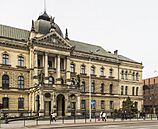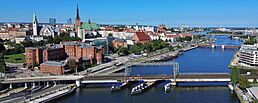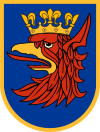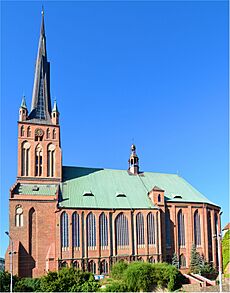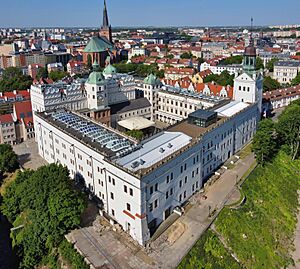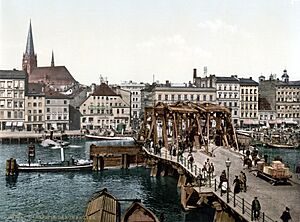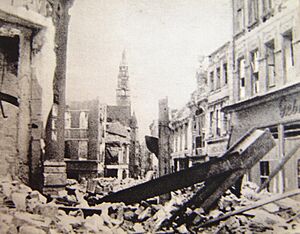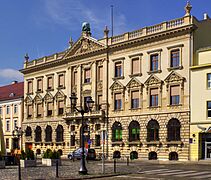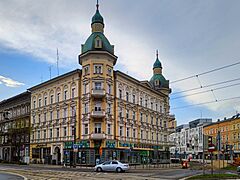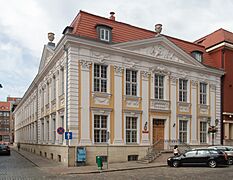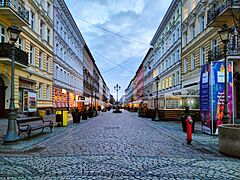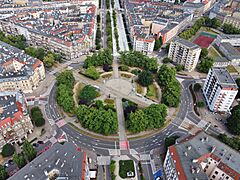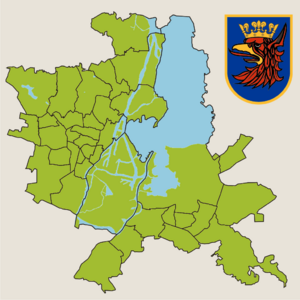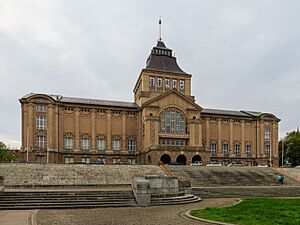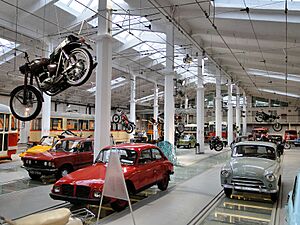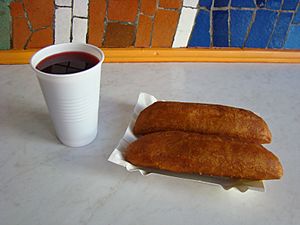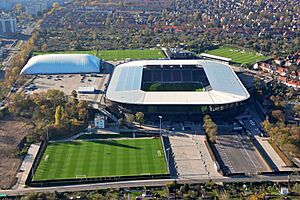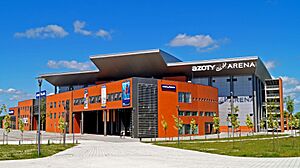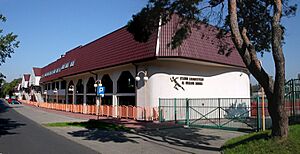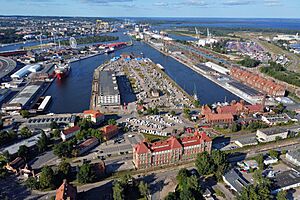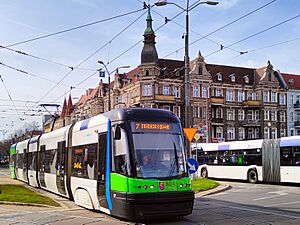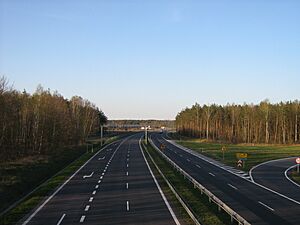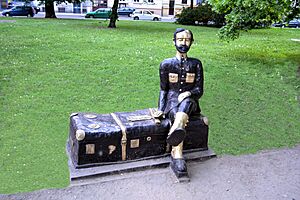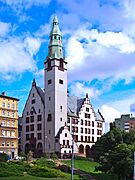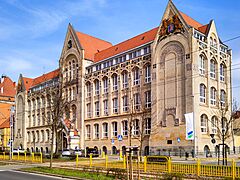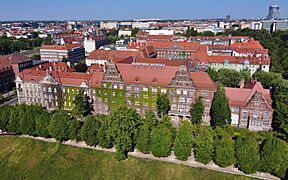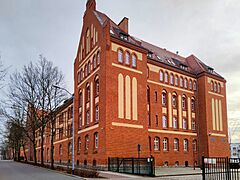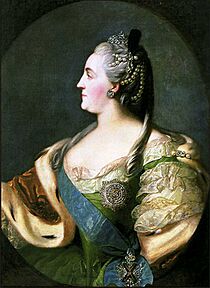Szczecin facts for kids
Quick facts for kids
Szczecin
Stettin
|
|||||
|---|---|---|---|---|---|
|
Art Academy
Hanza Tower
Old Town Hall
National Museum
Red Town Hall
Szczecin Philharmonic
Oder River, with the Cathedral in the distance
|
|||||
|
|||||
| Motto(s):
"Szczecin jest otwarty"
("Szczecin is open") |
|||||
| Country | |||||
| Voivodeship | West Pomeranian | ||||
| County | City county | ||||
| Established | 8th century | ||||
| City rights | 1243 | ||||
| Area | |||||
| • City | 301 km2 (116 sq mi) | ||||
| • Metro | 2,795 km2 (1,079 sq mi) | ||||
| Population
(31 December 2021)
|
|||||
| • City | 395,513 |
||||
| • Density | 1,340/km2 (3,500/sq mi) | ||||
| • Metro | 777,000 | ||||
| • Metro density | 278/km2 (720/sq mi) | ||||
| Time zone | UTC+1 (CET) | ||||
| • Summer (DST) | UTC+2 (CEST) | ||||
| Postal code |
PL-70-017
to 71–871 |
||||
| Area code(s) | +48 91 | ||||
| Car plates | ZS | ||||
| Climate | Cfb | ||||
| Primary airport | Solidarity Szczecin–Goleniów Airport | ||||
Szczecin is a large and important city in northwestern Poland. It is the capital of the West Pomeranian Voivodeship. The city is located close to the Baltic Sea and the border with Germany. It is a major seaport and the seventh-largest city in Poland. As of 2022, about 391,566 people live there.
Szczecin sits on the Oder River. It is south of the Szczecin Lagoon and the Bay of Pomerania. The city is built on both sides of the Oder. It also includes several large islands in the river. Szczecin is surrounded by thick forests and heaths. These include the Wkrzańska Heath and the Szczecin Landscape Park.
The city's history goes back over 1,300 years. Different groups like the Vikings and Lechites built strongholds here. Over time, Szczecin was part of many different countries. These included Piast Poland, Denmark, Sweden, Prussia, and Germany. Today, it is part of modern Poland. The city's buildings show its long history. You can see styles like Brick Gothic and Neoclassical. Szczecin's city plan is unique. It is based on the Orion constellation, with wide avenues and roundabouts. Key landmarks include the Szczecin Cathedral and the Ducal Castle.
Szczecin is a center for industry and administration. It has several important universities. These include the University of Szczecin and the Maritime University of Szczecin. Since 1999, it has been home to the headquarters of NATO's Multinational Corps Northeast. The city was also considered to be a European Capital of Culture in 2016.
Contents
What's in a Name?
The names Szczecin (Polish) and Stettin (German) mean the same thing. They come from an old Slavic language. Experts are still studying exactly where the name came from.
Some ideas for the name's origin include:
- An Old Slavic word for 'hill peak'.
- The plant called fuller's teasel.
- A personal name like Szczota.
In old times, the city was also called Burstaborg or Burstenburgh. These names mean 'brush burgh'. They might come from the Slavic name if it related to the teasel plant.
A Journey Through Time
Early History of Szczecin

Szczecin's recorded history began in the 700s. This is when Vikings and West Slavs settled in the area. The West Slavs built a new stronghold where the modern castle stands today.
By the 800s, the stronghold was made stronger. It grew towards the Oder River. In the 900s, Mieszko I of Poland took control of the region. This made Szczecin part of Poland. However, later Polish rulers lost some control.
Szczecin became a very important seaport on the Baltic Sea. This happened after the nearby city of Wolin declined in the 1100s.
Polish Rule and Christianization
In 1121–1122, Bolesław III Wrymouth, the Duke of Poland, took control of Szczecin. He started to bring Christianity to the area. Otto of Bamberg led two missions in 1124 and 1128. The first Christian church, Ss Peter and Paul, was built then. Polish coins were used for trade. The city had about 5,000 to 9,000 people.
Polish rule ended in 1138. In 1147, a group of crusaders attacked the town. But the people of Szczecin had already become Christians. So, the attack was stopped.
Changing Rulers and German Settlement
After some battles, Szczecin became a vassal of different powers. These included Saxony and Denmark. In 1181, it became a vassal of the Holy Roman Empire. Despite this, local dukes stayed close to Poland.
In the late 1100s, German traders settled in Szczecin. They built St. Jacob's Church. Duke Barnim I of Pomerania gave Szczecin a special charter in 1237. This separated the German settlement from the Slavic community.
In 1243, Barnim I gave Szczecin Magdeburg rights. This meant the city could govern itself. Part of the Slavic settlement was rebuilt. Most Slavic people moved to new areas outside the town.
In 1249, Barnim I also gave town rights to Damm. This town later joined Szczecin in 1939. It is now the Dąbie neighborhood.
In 1273, the future King of Poland, Przemysł II, married Princess Ludgarda in Szczecin. This helped strengthen ties between their families.
Hanseatic League and Prosperity
Szczecin joined the Hanseatic League in 1283. This was a powerful group of trading cities. The city grew rich from trade in the Baltic Sea. They traded things like herring, grain, and timber. Many craft guilds were also formed.
During this time, policies against Slavic people became stronger. Slavic merchants had to pay more taxes. They were also banned from joining guilds. Some Slavic citizens lost their property.
In 1570, a peace treaty was signed in Szczecin. This ended the Northern Seven Years' War. The city became an important place for coining money.
Swedish and Prussian Rule
After a treaty in 1630, Sweden took control of Szczecin. It became the capital of Swedish Pomerania. Szczecin was made a strong Swedish fortress. It was attacked many times in later wars.
In 1720, Sweden had to give Szczecin to Prussia. Szczecin became the capital of the Prussian province of Pomerania. The city's population grew to 26,000 by 1816.
The Prussian government changed how the city was run. They encouraged French Huguenots to settle there. These French settlers helped the city's economy grow.
1800s and Early 1900s
In 1806, during a war, the Prussian commander surrendered Szczecin to the French. This was a surprising event because the French had far fewer soldiers. French troops stayed until 1813.
In 1812, a law allowed Jewish people to settle in Prussia. A Jewish community then grew in Szczecin. They built a synagogue and schools.
Until 1873, Szczecin was a fortress. When its defenses were removed, new areas were built. The city grew quickly. Its population rose from 27,000 in 1813 to 210,000 in 1900.
Szczecin became a major Prussian port and part of the German Empire in 1871. Industries like shipbuilding and chemical production grew. The city also became connected by railways.
In 1890, some Polish residents created a Polish organization. By 1914, over 3,000 Poles lived in the city. They were mostly industrial workers.
Between World War I and World War II, Szczecin was Germany's largest port on the Baltic Sea. Cars were made by the Stoewer company in Szczecin. A highway connecting Berlin to Szczecin was finished by 1939.
The Polish minority in Szczecin faced difficulties. Their organizations were eventually closed by German authorities in 1939.
World War II and After
During World War II, Szczecin was a German military base. In 1939, nearby towns joined Szczecin. This made it a very large city by area.
Many non-Germans were brought to the city as forced laborers. Most were Poles. There were 135 forced labor camps in the city. A Nazi prison also operated there.
In 1940, Jewish residents of Szczecin were forced to leave. This was the first time Jews were deported from pre-war Germany.
Allied air raids in 1944 caused great damage. About 65% of the city's buildings were destroyed. The city center, port, and industries were badly hit. Polish resistance groups helped the Allies by providing information.
The Soviet Red Army captured Szczecin on April 26, 1945. Most of the city's residents had left. After the war, Szczecin became part of Poland. This was decided by the Allied powers. The city was renamed to its historic Polish name, Szczecin.

After the war, German residents were systematically moved out. Polish people from other regions settled in Szczecin. The city's population grew again. Szczecin was rebuilt and its industries expanded. It became an important port for Poland and other countries.
Szczecin saw protests against the communist government in 1956, 1970, and 1980. In 1980, the first of the August Agreements was signed in Szczecin. This led to the legal recognition of the Solidarity trade union. Strikes continued in the 1980s. These events helped lead to Poland's transition to democracy.
Since 1999, Szczecin has been the capital of the West Pomeranian Voivodeship.
City Layout and Buildings
Climate and Weather
Szczecin has an oceanic climate. This means it has mild winters and warm summers. The average temperature is about 8 to 8.4 degrees Celsius. July is the warmest month, and January is the coldest. The city gets about 537 mm of rain each year.
| Climate data for Szczecin (Szczecin Dąbie), elevation: 1 m, 1991-2020 normals, extremes 1951–present | |||||||||||||
|---|---|---|---|---|---|---|---|---|---|---|---|---|---|
| Month | Jan | Feb | Mar | Apr | May | Jun | Jul | Aug | Sep | Oct | Nov | Dec | Year |
| Record high °C (°F) | 15.5 (59.9) |
17.9 (64.2) |
23.9 (75.0) |
30.6 (87.1) |
32.0 (89.6) |
35.6 (96.1) |
37.3 (99.1) |
37.8 (100.0) |
30.8 (87.4) |
26.7 (80.1) |
19.4 (66.9) |
14.9 (58.8) |
37.8 (100.0) |
| Mean maximum °C (°F) | 9.8 (49.6) |
11.6 (52.9) |
17.2 (63.0) |
23.8 (74.8) |
27.5 (81.5) |
30.3 (86.5) |
31.6 (88.9) |
31.8 (89.2) |
25.7 (78.3) |
20.5 (68.9) |
14.2 (57.6) |
10.8 (51.4) |
33.7 (92.7) |
| Mean daily maximum °C (°F) | 3.0 (37.4) |
4.5 (40.1) |
8.5 (47.3) |
14.7 (58.5) |
19.1 (66.4) |
22.1 (71.8) |
24.3 (75.7) |
24.0 (75.2) |
19.2 (66.6) |
13.5 (56.3) |
7.5 (45.5) |
4.0 (39.2) |
13.7 (56.7) |
| Daily mean °C (°F) | 0.6 (33.1) |
1.5 (34.7) |
4.2 (39.6) |
9.2 (48.6) |
13.6 (56.5) |
16.8 (62.2) |
18.9 (66.0) |
18.5 (65.3) |
14.3 (57.7) |
9.5 (49.1) |
4.9 (40.8) |
1.9 (35.4) |
9.5 (49.1) |
| Mean daily minimum °C (°F) | −1.8 (28.8) |
−1.3 (29.7) |
0.4 (32.7) |
4.0 (39.2) |
8.2 (46.8) |
11.5 (52.7) |
13.8 (56.8) |
13.5 (56.3) |
9.9 (49.8) |
6.0 (42.8) |
2.4 (36.3) |
−0.5 (31.1) |
5.5 (41.9) |
| Mean minimum °C (°F) | −11.8 (10.8) |
−9.9 (14.2) |
−7.3 (18.9) |
−3.2 (26.2) |
1.1 (34.0) |
5.7 (42.3) |
8.2 (46.8) |
7.2 (45.0) |
3.0 (37.4) |
−2.1 (28.2) |
−4.8 (23.4) |
−8.6 (16.5) |
−15.0 (5.0) |
| Record low °C (°F) | −30.0 (−22.0) |
−28.7 (−19.7) |
−23.1 (−9.6) |
−7.7 (18.1) |
−4.4 (24.1) |
0.3 (32.5) |
4.4 (39.9) |
1.2 (34.2) |
−2.6 (27.3) |
−6.9 (19.6) |
−11.4 (11.5) |
−22.3 (−8.1) |
−30.0 (−22.0) |
| Average precipitation mm (inches) | 40.0 (1.57) |
32.8 (1.29) |
38.4 (1.51) |
31.2 (1.23) |
55.8 (2.20) |
59.1 (2.33) |
76.2 (3.00) |
60.3 (2.37) |
47.7 (1.88) |
43.5 (1.71) |
39.0 (1.54) |
43.0 (1.69) |
567.1 (22.33) |
| Average extreme snow depth cm (inches) | 3.6 (1.4) |
4.0 (1.6) |
1.9 (0.7) |
0.4 (0.2) |
0.0 (0.0) |
0.0 (0.0) |
0.0 (0.0) |
0.0 (0.0) |
0.0 (0.0) |
0.0 (0.0) |
0.7 (0.3) |
2.3 (0.9) |
4.0 (1.6) |
| Average precipitation days (≥ 0.1 mm) | 16.13 | 14.54 | 13.53 | 11.07 | 13.57 | 13.07 | 14.17 | 13.10 | 11.93 | 14.07 | 14.60 | 16.87 | 166.64 |
| Average snowy days (≥ 0 cm) | 7.6 | 6.9 | 2.8 | 0.4 | 0.0 | 0.0 | 0.0 | 0.0 | 0.0 | 0.0 | 1.3 | 4.7 | 23.7 |
| Average relative humidity (%) | 87.1 | 83.3 | 78.2 | 70.8 | 71.5 | 72.9 | 74.4 | 75.9 | 81.2 | 85.5 | 89.1 | 89.0 | 79.9 |
| Average dew point °C (°F) | −1 (30) |
−1 (30) |
0 (32) |
3 (37) |
8 (46) |
11 (52) |
13 (55) |
13 (55) |
10 (50) |
7 (45) |
3 (37) |
0 (32) |
6 (42) |
| Mean monthly sunshine hours | 42.7 | 66.7 | 121.2 | 199.3 | 244.5 | 242.3 | 246.3 | 230.3 | 160.0 | 105.7 | 47.4 | 32.2 | 1,738.6 |
| Average ultraviolet index | 0 | 1 | 2 | 4 | 5 | 6 | 6 | 5 | 4 | 2 | 1 | 0 | 3 |
| Source 1: Institute of Meteorology and Water Management | |||||||||||||
| Source 2: Meteomodel.pl (records, relative humidity 1991–2020), Weather Atlas (UV), Time and Date (dewpoints, 1985-2015) | |||||||||||||
Architecture and City Design
Szczecin's buildings show styles from the late 1800s and early 1900s. These include Academic art and Art Nouveau. In areas rebuilt after 1945, you can see social realism style.
The city has many green spaces. There are parks and wide avenues with trees. The streets and roundabouts are designed like the Orion constellation. This is because Szczecin was redesigned in the 1880s. It was based on a plan used for Paris.
After World War II, Polish authorities rebuilt the city. They wanted the buildings to look like old Polish styles. Since no buildings from that time existed, they chose Brick Gothic and Renaissance styles. These styles were linked to the Griffin dynasty. This family had Slavic roots.
The ruins of the former Griffin residence were rebuilt in Renaissance style. Buildings from the 1800s were not always saved. Many bricks from Szczecin were used to rebuild Warsaw. The Old Town was rebuilt in the late 1990s. Some new buildings look like those destroyed in the war.
Szczecin is part of the European Route of Brick Gothic. This route connects Gothic buildings in different cities. A part of the Szczecin Landscape Park is within the city limits. Szczecin also has 28 historic water pumps. They are colorful and a popular tourist sight.
City Districts
Szczecin is divided into districts called dzielnica. These are then split into smaller neighborhoods. Each neighborhood has a council. These councils help with local issues. They look after things like trees, park benches, and playgrounds.
The main districts are:
- Śródmieście (City Centre): Includes areas like Centrum and Stare Miasto.
- Północ (North): Includes areas like Bukowo and Warszewo.
- Zachód (West): Includes areas like Gumieńce and Pogodno.
- Prawobrzeże (Right-Bank): Includes areas like Dąbie and Podjuchy.
Museums and Fun Places
Museums and Galleries
Szczecin has several museums and galleries:
- National Museum in Szczecin: This is the biggest cultural place in the West Pomeranian Voivodeship. It has several parts:
- The Main Building.
- Szczecin's History Museum, located in the Old Town Hall, Szczecin.
- The Old Art Gallery.
- The Museum of Contemporary Art.
- The Narrow Gauge Railway Exhibition in Gryfice.
- The Castle Museum: Located in the Pomeranian Dukes' Castle, Szczecin.
- Museum of Technology and Transport.
Arts and Entertainment
Szczecin has many places for arts and entertainment:
- Theatres and Cinemas:
- The Castle Cinema.
- Pionier 1909 Cinema.
- Kana Theatre.
- Modern Theatre.
- Opera in the Castle.
- Polish Theatre in Szczecin.
- The Pleciuga Puppetry Theatre.
- Music:
- Szczecin Philharmonic.
- Historic Places:
- Bismarck tower Szczecin (ruins).
- The Quistorp's Tower (ruins).
- Napoleon mound.
- Monuments:
- The Monument of Sailor at Grunwald Square.
Delicious Local Food
Szczecin's food traditions were shaped by people who moved here after World War II. They came from different parts of Poland. Two very famous local dishes are pasztecik szczeciński and paprykarz szczeciński. Other local treats include Szczecin gingerbread and local beer.
Pasztecik szczeciński is a deep-fried dough. It is usually filled with minced meat. You can also find vegetarian fillings like cheese and mushrooms. It is often served with clear red borscht. The first place to serve pasztecik szczeciński opened in 1969.
Paprykarz szczeciński is a spread. It is made from fish paste mixed with rice, onion, and tomato paste. It also has oil, salt, and spices like chili powder. You can find it in most grocery stores.
Szczecin gingerbread (pierniki szczecińskie) is a traditional gingerbread. It is covered with chocolate or sugar glaze. The decorations often show city buildings or sea themes.
Szczecin beer (piwo szczecińskie) includes different types of Polish beer. These are light, amber, and wheat beer. The city has been brewing beer for over a thousand years.
The word "szczeciński" or "szczecińskie" means "from Szczecin". It shows where these foods come from.
Sports in Szczecin
Szczecin has many popular professional sports teams. The most popular sport is football, thanks to Pogoń Szczecin. Thousands of people in Szczecin also play amateur sports.
| Club | Sport | League | Trophies |
|---|---|---|---|
| Pogoń Szczecin | Football (men's) | Ekstraklasa | 0 |
| Pogoń Szczecin | Football (women's) | Ekstraliga | 1 Polish Championship (2024) |
| Wilki Morskie Szczecin | Basketball (men's) | Polish Basketball League | 1 Polish Championship (2023) |
| Świt Szczecin | Football (men's) | II liga | 0 |
| Pogoń Szczecin | Handball (women's) | Liga Centralna | 3 Polish Championships (1983, 1986, 1991) 4 Polish Cups (1971, 1980, 1986, 1992) |
| Pogoń Szczecin | Handball (men's) | Liga Centralna | 0 |
Many teams in Szczecin are named after Pogoń Lwów. This was a famous team from a city that is now in Ukraine.
Annual Sports Events
Every September, Szczecin hosts the Pekao Szczecin Open. This is a men's tennis tournament. In August, a marathon is held in the city.
Economy and Getting Around
Szczecin's Economy
Szczecin is a major center for the maritime economy. Over 13,000 people work in this field. The seaport serves ships from all over the world. It is also the home port for two shipping companies: Polsteam and Euroafrica.
In 2013, a special economic zone was created in Szczecin. This helps new businesses grow. In September 2016, the unemployment rate was 5.0%. The average monthly salary in Szczecin is about PLN 6733.49.
Szczecin's total economic output (GDP) is PLN 20.255 billion. This is about one-third of the entire province's GDP.
Travel and Transport
- Air Travel: Szczecin is served by Solidarity Szczecin–Goleniów Airport. It is about 47 kilometers (29 miles) northeast of the city center. There is also a small grass airstrip within the city.
- Trams: Szczecin has a tram network with 12 lines and 95 stops. The total length is about 110.77 kilometers (68.83 miles). The first horse tram opened in 1879. Electric trams started running in 1896.
- Buses: The city has 70 bus routes. There are normal lines, night buses, and express lines.
- Roads: The A6 motorway helps traffic bypass the city. It connects to the German A11 autobahn. You can reach Berlin in about 90 minutes. The S3 Expressway links Szczecin to cities further south. The S6 Expressway connects it to Koszalin.
- Rail: The main train station is Szczecin Główny railway station. Szczecin has good train links to its airport and other Polish cities. These include Poznań, Wrocław, and Warsaw. There are also connections to Germany, like Berlin.
- Port: The Port of Szczecin is the third largest port in Poland. It handles over 32 million tons of cargo each year. It is a port on the Baltic Sea and the Oder river.
Learning and Universities
Szczecin is an important center for education and science. It has many universities and schools:
- University of Szczecin: With 35,000 students.
- West Pomeranian University of Technology.
- Pomeranian Medical University in Szczecin.
- Art Academy of Szczecin.
- Maritime University of Szczecin.
- WSB Merito Universities.
- The West Pomeranian Business School.
- Higher School of Public Administration in Szczecin.
- High Theological Seminary in Szczecin.
- Universities in Szczecin
Scientific Groups
Szczecin is home to many scientific groups. These include:
- Western Pomeranian Institute.
- Szczecin Scientific Society.
- Local branches of Polish scientific societies in many subjects.
- Local branches of student societies like AIESEC.
Famous People from Szczecin
Many famous people were born or lived in Szczecin. These include:
- Empress Catherine the Great of Russia.
- Composer Carl Loewe.
- Writer Alfred Döblin.
- Actress Dita Parlo.
- Mathematician Hermann Günther Grassmann.
- Roman Catholic priest Carl Lampert.
- Poet Konstanty Ildefons Gałczyński.
- Helena Majdaniec, known as "the queen of Polish Twist".
- Singer Violetta Villas.
International Connections
Consulates
Szczecin has 15 honorary consulates. These are offices that help citizens from other countries. They represent countries like Denmark, France, Germany, and Sweden.
Twin Towns
Szczecin is twinned with several cities around the world. This means they have special friendly relationships.
- Bari, Italy
- Bremerhaven, Germany
- Dnipro, Ukraine
- Esbjerg, Denmark
- Friedrichshain-Kreuzberg (Berlin), Germany
- Greifswald, Germany
- Kingston upon Hull, United Kingdom
- Klaipėda, Lithuania
Images for kids
See also
 In Spanish: Szczecin para niños
In Spanish: Szczecin para niños


